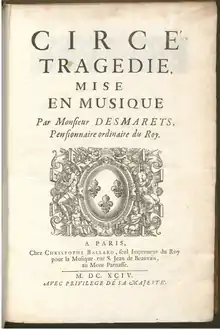Circé (Desmarets)
Circé (Circe) is an opera composed by Henri Desmarets to a libretto by Louise-Geneviève Gillot de Saintonge and first performed at the Académie Royale de Musique (the Paris Opera) on 1 October 1694. It takes the form of a tragédie en musique in a prologue and five acts. The piece concerns the sorceress Circe who appears in Greek mythology and in Homer's Odyssey.

Louise-Geneviève Gillot de Saintonge
The libretto for Circé was written by Louise Genevieve Gillot de Saintonge (1650–1718) and based on the Greek mythological character of that name. Saintonge was also a novelist. In addition to writing this libretto, she wrote the libretto for the opera Didob, also composed by Desmarets.
Henri Desmarets
Henri Desmarets (1661 – 1741) was a French composer in the Baroque era associated with the court of King Louis XIV. Though considered to be very talented, most of his works were not well received, and his personal life was troubled as well. He is known for his masterfully written sacred grands motets.[1]
Performance and reception
Circe was first performed in 1694 at the Paris Opera.[2] It was not received well; most of Desmarets' operas were said to have mimicked Lully's music in a way that produced material similar but inferior to it. No fault of Desmarets', Lully's monopoly on court music cast a shadow in which any potential individuality Desmarets had was quashed. This may have contributed to the generally negative sentiment toward his work evident in reviews written at the time.[3][4]
Circe in mythology
The eponymous character in this myth appears often in ancient literature as an enchantress well-versed in potions and sorcery. She is mainly associated with Homer's Odyssey. In this iteration of the tale, she lures the main character Odysseus and his crew to a wine- and potion-laced feast that leads Odysseus, with whom she has fallen in love, to remain on her island for a year. She then frees him and directs him home.
Tragédie en musique
Circe falls under the category of tragedie en musique (also known as tragedie lyrique), a genre of opera formed and popularized in the Baroque era by Lully and carried on until the end of the period. Operas in this genre served the purpose of edifying the king and exemplify regality with stately rhythmic structures and consonant harmonies. Most were based on Greek myth and tragedy, hence its name, literally "tragedy set to music."[5]
Score
Though the similarities between Desmarets' and Lully's music were written off by bitter critics as the sign of a composer failing to come into his own, the use of one of Desmarets' musical structures in later music suggests quietly admitted approval within the musical community. At the time one trend was to highlight low voices and sonorities, which the composer furthered through choruses that featured a single exposed melody to be sung by bass voices. This can be seen in the songes affreux in Circe.
The prologue is a good example of the homophony characteristic of French music at the time the opera was written, and includes points of imitation, or repeated material in succession between different instrument and voice parts which may mimic a fugue.
The most popular excerpt of the piece is the rigaudon transcribed by Ernst Pauer for piano.
References
- Mason Greene, David (1985). Greene's Biographical Encyclopedia of Composers. Doubleday and Company. pp. 186–187.
- Taruskin, Richard. Oxford History of Western Music: Music in the Seventeenth and Eighteenth Centuries. Oxford.
- Sadle, Stanley. New Grove Dictionary of Opera. Grove's Dictionaries of Music.
- Sadle, Stanley. Oxford Dictionary of Music and Musicians. Oxford.
- Anthony, James R. French Baroque Music from Rameau to Beaujoyeulx.
Further reading
- Clément, Félix; Larousse, Pierre (1881). Dictionnaire des Opéras (in French). Paris. p. 163.